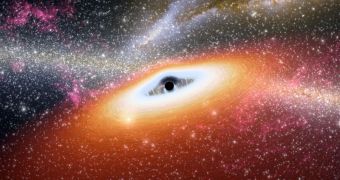Identifying the components of dark matter is currently one of the most important efforts in physics. In a recent study, astrophysicists eliminated some primordial black holes as potential candidates for the primary constituents of dark matter, but they have also established that others may very well provide the foundation of this elusive type of matter.
Dark matter is known to exist solely through the gravitational influences it exerts on normal, baryonic matter. Astrophysicists know that it permeates galaxies, and that filaments of the stuff connect galaxies, forcing them to clump up in massive clusters.
According to previous studies, dark matter accounts for about 85 percent of all matter in the Universe, or roughly a quarter of the mass-energy budget of the Cosmos. However, no one has been able to identify what this type of matter is made of.
Theories explaining its structure range from weakly-interacting massive particles (WIMP) and primordial black holes (PBH) to supermassive black holes (SMBH). Investigations conducted with the world's most advanced dark matter detectors have thus far failed to find any sign of WIMP.
At the same time, studies conducted using the NASA Kepler Space Telescope have all but eliminated SMBH – such as the one at the core of the Milky Way – as the potential source of dark matter. In the latest study, researchers found that some PBH can be ruled out as well, but not all.
In other words, it may still be possible that certain types of primordial black holes make up dark matter. PBH have never been detected in practice, but they are hypothesized to be very small black holes that appeared when the Universe was just a fraction of its current age.
“We've ruled out a range of primordial black holes as dark matter, but have not ruled them out completely. They're still a viable candidate for dark matte,” says University of California in San Diego (UCSD) astrophysicist Kim Griest, quoted by Space.
The UCSD team published details of their newest study in the October 31 online issue of the esteemed scientific journal Physical Review Letters.
“Dark matter searches are normally very hard, involving experiments that take millions of dollars and decades to build. What's so cool and fun about this work is that we could use this experiment that was already built for completely different purposes to look for dark matter,” Griest says.
The astrophysicist adds that future space exploration missions could be used to detect signs of primordial black hole. Among the spacecraft that would be capable of doing this, Griest mentions the proposed NASA WFIRST mission and the Euclid satellite developed by the European Space Agency.

 14 DAY TRIAL //
14 DAY TRIAL //